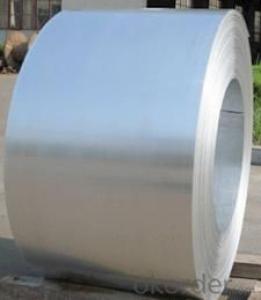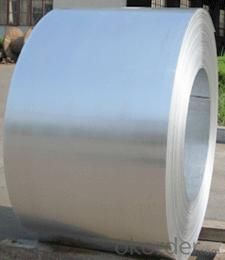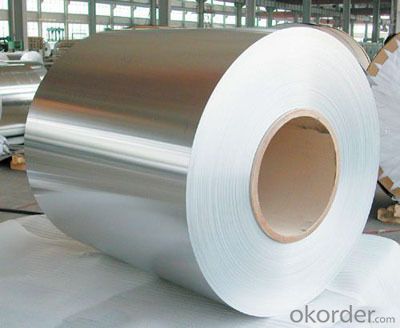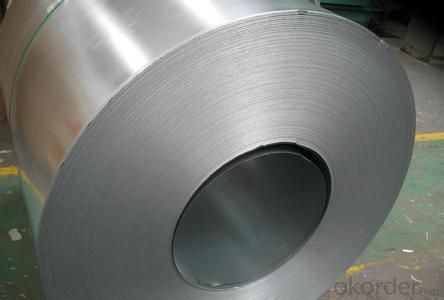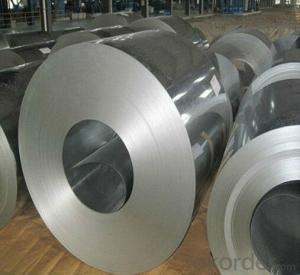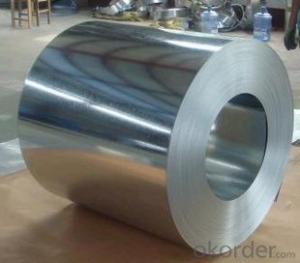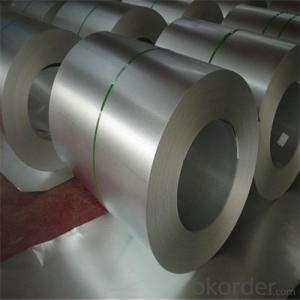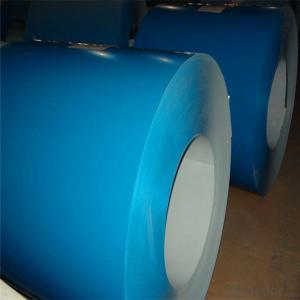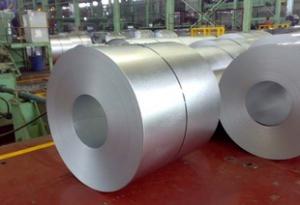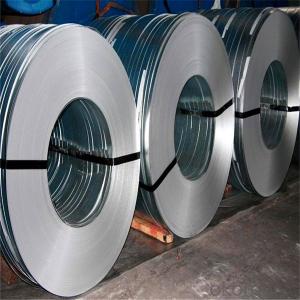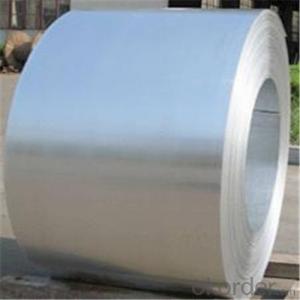Structual Quality Hot Dipped Aluzinc Steel Coil
- Loading Port:
- China Main Port
- Payment Terms:
- TT OR LC
- Min Order Qty:
- -
- Supply Capability:
- -
OKorder Service Pledge
Quality Product, Order Online Tracking, Timely Delivery
OKorder Financial Service
Credit Rating, Credit Services, Credit Purchasing
You Might Also Like
Aluzinc Steel Coil
Steel Grade & Standard:G550
Spangle:Minimized Spangle
Aluzinc Coating Mass:AZ40
Surface Treatment:Chromated, Unoiled, NonSkinpassed, Anti-Finger Print
Size: MOQ (MTS)
0.21mm x 914mm x coil 40
0.23mm x 914mm x coil 40
0.25mm x 914mm x coil 40
0.28mm x 914mm x coil 40
Package Type:EYE TO SIDE
Thickness Tolerance:+/-0.01mm
Width Tolerance:0/+5mm
Quantity Tolerance: +/-10%
VALIDITY: 3 WORKING DAYSPAYMENT: T/T WITH 30% DOWNPAYMENT AND BALANCE AGAINST INVOICE & PACKING LISTSHIPMENT: 50 DAYS FOR CARGO READINESS AND 15 DAYS FOR CATCHING THE RIGHT VESSELOTHERS: ALL WORDS AND SENTENCES SHOULD BE IN ENGLISH
- Q: If rail ties were melted, would they be like any other type of steel?
- As so much about the railroad is variable, so is the steel used for the rail. For one thing, all rail is not the same size. It is classified by weight per yard. For example, most tangent (straight) track is 139 lbs rail, meaning three feet of it weighs this much. Secondary track, such as found on branch lines and in yards or used on sidings is not as heavy. Track used in curvature may be the same weight, but not always. The reason is there is much more stress imparted to the roadbed in curvature. Most steel on main tracks has a higher carbon content, but there is a point of diminishing returns, as this rail is more brittle as a result. Good luck trying to melt it. In the field, this rail is cut by a saw with diamond studded circular blades. The reason why is it takes a lot more time to try to cut it with an acetylene torch. In the US, certain areas, such as on some bridges, the cross-ties (sleepers) are indeed made of steel, in addition to concrete and wood. The potential for fire is too great for wood in these instances. In addition, if even a single wheel derails, concrete ties tend to explode when stressed this way. All of which makes steel cross-ties worth the extra cost.
- Q: What are the common manufacturing defects in steel coils?
- Common manufacturing defects in steel coils include surface defects such as scratches, pits, and scale, as well as shape defects like buckling, waviness, and edge cracks. Additionally, internal defects such as voids, inclusions, and segregation may also be present in steel coils.
- Q: What are the dimensions of steel coils used in the building materials industry?
- The specific application and requirements determine the varying dimensions of steel coils in the building materials industry. Typically, steel coils in this industry have a thickness ranging from 0.5mm to 3mm and a width ranging from 600mm to 1500mm. The length of the coil can vary based on the manufacturer and customer specifications. It is important to note that the weight of the coil also varies, with typical weights ranging from a few hundred kilograms to several tonnes, depending on the size and thickness of the coil. Ultimately, the dimensions of steel coils in the building materials industry are determined by the specific needs and specifications of the intended construction projects.
- Q: Why is steel a stiff material?I'm doing a project on the use of steel in the construction of skyscrapers - and obviously, for the inner steel skeleton of a skyscraper the steel support beams and girders will have to be stiff so that they don't fall apart or the building doesn't shake due to wind or other natural forces.But in my research I've found that steel (mild steel to be more exact) is ductile and malleable, meaning it can be shaped fairly easily. However, how can steel ALSO be stiff - the definition of stiffness is the tendency to withstand bending and stretching - so my question is. How can this material be BOTH ductile/malleable, AND stiff? and why? :)Thank you in advance if anyone takes the time to answer this, would be appreciated - I'll give you 10 points straight away if the answers conclusive
- To say that steel can be bent and shaped fairly easily isn't quite true. It takes multiple tons of force to do so, requiring some very heavy machinery. I think you're confusing a couple of concepts. For example the idea of elastic modulus, versus rigidity Rigidity is the ability of a structure to resist a load. That depends not only on the elastic modulus, but on the size and design of the structure or object. You can build fairly rigid structures out of wood. For example roller coasters. Even though wood has a much lower elastic modulus than steel, meaning that it takes much less force to bend and deform a given sample of wood.
- Q: What are the different surface treatments available for steel coils?
- There are various surface treatments available for steel coils, including galvanizing, painting, powder coating, and zinc coating. These treatments help protect the steel from corrosion and improve its durability and appearance.
- Q: How are steel coils used in the production of electrical transmission poles?
- Steel coils are an essential component in the production of electrical transmission poles. These coils are made from high-quality steel and are used to fabricate the poles with the necessary strength and durability to withstand the demanding conditions of electrical transmission. Firstly, steel coils are used to manufacture the main body of the transmission poles. The coils are unrolled and shaped into large cylindrical sections, which are then welded together to form the pole's structure. This process allows for the creation of poles in various lengths, diameters, and wall thicknesses, catering to specific transmission requirements. The use of steel coils ensures that the transmission poles have the necessary structural integrity to support heavy electrical conductors and withstand environmental factors such as wind, ice, and seismic activities. Steel is known for its high strength-to-weight ratio, making it an ideal material for these poles, as it provides the required strength while keeping the pole relatively lightweight. Moreover, steel coils are also used to fabricate the flanges and brackets that are attached to the poles. These components are essential for securing and supporting the electrical conductors and insulators on the poles. By using steel coils, these flanges and brackets can be manufactured with precise dimensions and strength, ensuring a secure and reliable connection between the electrical components and the transmission poles. In addition to their structural benefits, steel coils also offer excellent corrosion resistance. This is crucial in the production of electrical transmission poles, as they are often exposed to harsh weather conditions and corrosive environments. Steel coils are typically coated with protective layers such as zinc or epoxy to prevent rust and corrosion, enhancing the lifespan of the transmission poles. In conclusion, steel coils play a vital role in the production of electrical transmission poles. They are used to fabricate the main body of the poles, as well as the flanges and brackets that secure the electrical components. With their high strength, durability, and corrosion resistance, steel coils ensure that transmission poles can safely and reliably support electrical conductors for the efficient transmission of electricity.
- Q: How do steel coils contribute to the agricultural industry?
- Steel coils are essential in the agricultural industry as they are used to manufacture various equipment and machinery. From tractors and harvesters to irrigation systems and storage tanks, steel coils provide the necessary strength and durability required for these agricultural applications. Additionally, steel coils are used in the construction of infrastructure like barns, silos, and fences, ensuring the safe storage and protection of crops and livestock. Overall, the use of steel coils in the agricultural industry helps enhance productivity, efficiency, and sustainability in farming operations.
- Q: How are steel coils unloaded from a truck or ship?
- Steel coils are typically unloaded from a truck or ship using various equipment and techniques. The unloading process depends on the type and size of the coils, as well as the available resources and infrastructure at the unloading site. For unloading from a truck, a common method involves the use of a forklift or crane equipped with coil hooks. The coils are carefully lifted and positioned onto the ground or a designated storage area. Alternatively, some trucks may be equipped with specialized roll-off trailers that allow the coils to be rolled off the truck bed. When unloading from a ship, larger cranes are often used due to the size and weight of the coils. These cranes can be located either on the ship itself or on the dock. The coils are lifted from the ship's cargo hold using specialized lifting hooks or spreader bars and carefully lowered onto the dock or a waiting truck. In some cases, a coil transfer car or coil trailer may be utilized to move the coils from the ship's cargo hold to the unloading area. These devices are designed to transport and position the coils safely and efficiently. It is worth noting that safety measures are of utmost importance during the unloading process. Proper securing of the coils, equipment stability, and adherence to weight limits are crucial to prevent accidents or damage to the coils, the truck, or the ship. Overall, the unloading of steel coils from trucks or ships involves the use of specialized equipment such as cranes, forklifts, and coil hooks. These tools, along with proper planning and safety precautions, ensure the efficient and safe transfer of the coils to their designated storage or transportation areas.
- Q: I just bought a dpms ar15 and it says if I shoot steel cases (laquer coated) or foreign ammo it voids the warranty. But before I knew this I bought 200 rounds of Russian steel cased anmo. Think I should just shoot there two hundred and not buy anymore? Some people say all they shoot is steel cased ammo and have no problemAny advice is appreciated
- Steel Case Ammo
- Q: How are steel coils used in the manufacturing of metal structures?
- Steel coils are commonly used in the manufacturing of metal structures as they provide a convenient and efficient way to shape and form various components. These coils are unrolled and then processed through machinery that cuts, bends, and shapes the steel into the desired size and shape. This allows for precise and consistent fabrication, making it easier to assemble and construct metal structures such as buildings, bridges, and machinery.
Send your message to us
Structual Quality Hot Dipped Aluzinc Steel Coil
- Loading Port:
- China Main Port
- Payment Terms:
- TT OR LC
- Min Order Qty:
- -
- Supply Capability:
- -
OKorder Service Pledge
Quality Product, Order Online Tracking, Timely Delivery
OKorder Financial Service
Credit Rating, Credit Services, Credit Purchasing
Similar products
Hot products
Hot Searches
Related keywords
